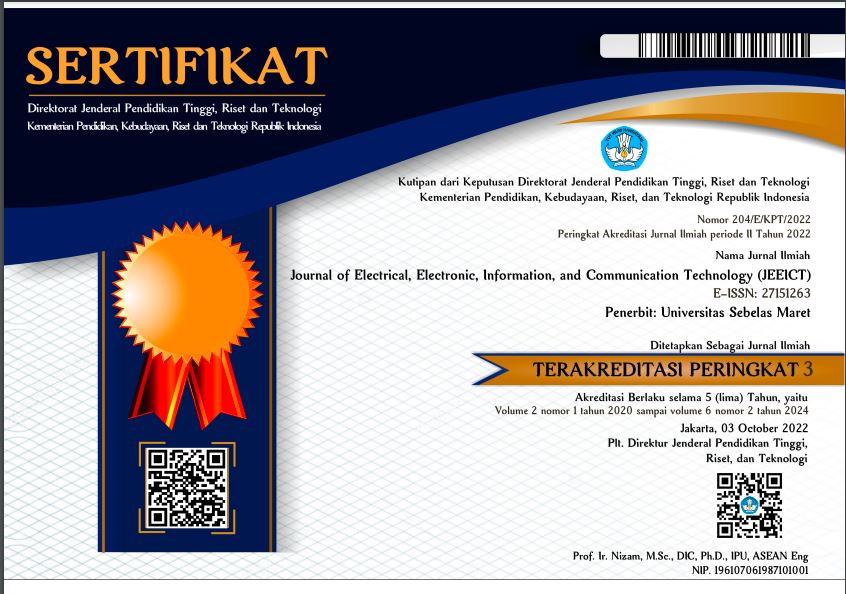Dress Code Selection Recommender System Based on Smartphone
Abstract
In the era of rapidly developing information technology, the existence of smartphones has become an integral part of everyday life. Appearance and choice of dress code play a crucial role in a person's self-image. Therefore, this research aims to design a smartphone-based dress code selection recommendation system. This system will use clothing usage data, user preferences, and event context to provide relevant dress code recommendations. With this solution, it is hoped that users can easily and efficiently choose the appropriate dress code, increase self-confidence, and create a pleasant dressing experience. This research contributes to the development of smartphone-based applications to support users' lifestyle and personal appearance. This application not only provides dress code inspiration, but also makes it easier for users to make decisions regarding clothing choices. Model testing using Machine Learning with the K-Nearest Neighbor (KNN) algorithm shows satisfactory accuracy, precision and recall, namely 83.67%, 83.82% and 99.34%. This application has the potential to be a useful tool helping users live an informed fashion lifestyle and according to personal preferences, and also minimize the waste of time that would occur when choosing clothes.
Full Text:
PDFReferences
Gufran and I. Mataya, “Pemanfaatan E-Modul Berbasis Smartphone Sebagai Media Literasi Masyakarat,” J. dan Pendidik. Ilmu Sos., vol. 4, no. 2, pp. 10–15, 2020, [Online]. Available: http://ejournal.mandalanursa.org/index.php/JISIP/index
E. Wardani, “Gaya Hidup BeragamaKomunitas Hijabers di KotaPadang,” Indones. J. Relig. Soc., vol. 01, no. 01, pp. 24–37, 2019, Accessed: Dec. 12, 2023. [Online]. Available: www.journal.lasigo.org/index.php/IJRS
D. F. Murad, S. A. Murad, and M. Irsan, “the Effect of Contextual Information As an Additional Feature in the Recommendation System,” J. Educ. Online, vol. 20, no. 1, 2023, doi: 10.9743/JEO.2023.20.1.10.
N. Arsita and V. F. Sanjaya, “Pengaruh Gaya Hidup Dan Trend Fashion Terhadap Keputusan Pembelian Online Produk Fashion Pada Media Sosial Instagram,” J. Ilmu Manaj. Saburai, vol. 07, no. 02, pp. 125–131, 2021.
E. Maiyana, “Pemanfaatan Android Dalam Perancangan Aplikasi Kumpulan Doa,” J. Sains dan Inform., vol. 4, no. 1, pp. 54–65, Apr. 2018, doi: 10.22216/jsi.v4i1.3409.
I. N. Farida and R. Firliana, “Perancangan Sistem Rekomendasi Jurusan Berdasarkan Potensi Siswa Menggunakan Metode Profile Matching,” Semin. Nas. Teknol. Inf. dan Multimed., vol. 2, no. 9, pp. 13–18, 2017.
I. P. Putri, “Analisis Performa Metode K-Nearest Neighbor (KNN) dan Crossvalidation pada Data Penyakit Cardiovascular,” Indones. J. Data Sci., vol. 2, no. 1, pp. 21–28, 2021.
M. Peleš, S. Jevremović, A. Simović, and A. Hadžić, “Possibilities for developing and implementing a mobile application for recognizing the shape of the environment, text, and reading QR codes using the Android CameraX framework and the Machine Learning Kit,” Procedia Econ. Bus. Adm., 2021, doi: 10.26458/v6.i1.x.
B. Asefa, “Building Android Component Library Using Jetpack Compose,” Theses Publ. Univ. Appl. Sci., pp. 1–42, Mar. 2022.
R. Hidayatullah, A. Hadiansa, S. Dumai, A. Dumai, and J. Utama Karya Bukit Batrem Dumai-Riau, “Perancangan Permainan Ular Tangga Multiplayer Berbasis Android,” MEDIA Inform. BUDIDARMA, vol. 2, no. 3, pp. 91–98, 2018, Accessed: Dec. 12, 2023. [Online]. Available: http://ejurnal.stmik-budidarma.ac.id/index.php/mib
A. Kurniawan, “Perancangan Aplikasi E-Voting pada Pemilihan Ketua Osis Berbasis Mobile,” J. Ilm. Inform. dan Ilmu Komput., vol. 2, no. 1, pp. 26–31, Mar. 2023, doi: 10.58602/jima-ilkom.v2i1.15.
M. Ropianto et al., “Perancangan Dashboard Sebagai Sistem Informasi Di Dinas Perumahan Rakyat, Pemukiman Dan Pertamanan Kota Batam,” JR J. Responsive, vol. 2, no. 2, pp. 123–133, 2018.
Desta Yolanda, Mohammad Hafiz Hersyah, and Eno Marozi, “Implementasi Metode Unsupervised Learning Pada Sistem Keamanan Dengan Optimalisasi Penyimpanan Kamera IP,” J. RESTI (Rekayasa Sist. dan Teknol. Informasi), vol. 5, no. 6, pp. 1099–1105, Dec. 2021, doi: 10.29207/resti.v5i6.3552.
K. A. Chandra and S. Hansun, “Sistem Rekomendasi Pemilihan Laptop dengan Metode WASPAS,” J. ECOTIPE, vol. 6, no. 2, pp. 76–81, 2019, doi: 10.33019/ecotipe.v5i2.xxx.
M. D. Purbolaksono, M. Irvan Tantowi, A. Imam Hidayat, and A. Adiwijaya, “Perbandingan Support Vector Machine dan Modified Balanced Random Forest dalam Deteksi Pasien Penyakit Diabetes,” J. RESTI (Rekayasa Sist. dan Teknol. Informasi), vol. 5, no. 2, pp. 393–399, Apr. 2021, doi: 10.29207/resti.v5i2.3008.
A. Dwiki, A. Putra, and S. Juanita, “Analisis Sentimen Pada Ulasan Pengguna Aplikasi Bibit Dan Bareksa Dengan Algoritma KNN,” J. Tek. Inform. dan Sist. Inf., vol. 8, no. 2, pp. 636–646, 2021, [Online]. Available: http://jurnal.mdp.ac.id
Rubangi and Rianto, “Sistem Rekomendasi Pada Tokopedia Menggunakan Algoritma K-Nearest Neighbor,” J. Tek. Komput. AMIK BSI, vol. 8, no. 1, pp. 103–107, 2022, doi: 10.31294/jtk.v4i2.
M. M. Baharuddin, H. Azis, and T. Hasanuddin, “Analisis Performa Metode K-nearest Neighbor Untuk Identifikasi Jenis Kaca,” Ilk. J. Ilm., vol. 11, no. 3, pp. 269–274, Dec. 2019, doi: 10.33096/ilkom.v11i3.489.269-274.
D. Yanosma, A. Johar T, and K. Anggriani, “Implementasi Metode K-Nearest Neighbor (KNN) Dan Simple Addittive Weighting (SAW) Dalam Pengambilan Keputusan Seleksi Penerimaan Anggota Paskibraka (Studi Kasus: Dinas Pemuda Dan Olahraga Provinsi Bengkulu),” J. Rekursif, vol. 4, no. 2, pp. 222–235, 2016.
Y. A. Putra, Sumijan, and Mardison, “Perancangan Sistem Informasi Akademik Menggunakan Bahasa Pemrograman PHP Dan Databse MySQL (Studi Kasus PAUD Terpadu Bissmillah Kota Bukittinggi),” J. Teknol. , vol. 9, no. 1, pp. 26–40, 2019.
A. H. Ataş and B. Çelik, “Smartphone Use of University Students: Patterns, Purposes, and Situations,” Malaysian Online J. Educ. Technol., vol. 7, no. 2, pp. 54–70, Apr. 2019, doi: 10.17220/mojet.2019.02.004.Refbacks
- There are currently no refbacks.







